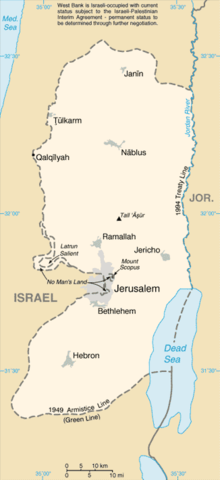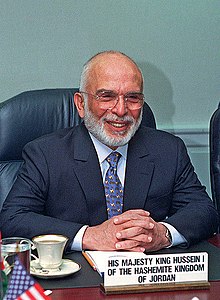| Revision as of 03:36, 14 December 2007 view source72.88.236.221 (talk)No edit summary← Previous edit | Revision as of 07:56, 8 January 2008 view source Pedrito (talk | contribs)2,399 editsm moved Rule of the West Bank and East Jerusalem by Jordan to Occupation of the West Bank and East Jerusalem by Jordan over redirect: Consistency with other military occupation articles, as per List of military occupations.Next edit → |
| (No difference) | |
Revision as of 07:56, 8 January 2008

The West Bank and East Jerusalem were ruled by Jordan (formerly Transjordan) for a period of nearly two decades (1948 - 1967) starting from the 1948 Arab-Israeli War. In 1950, with British approval, and despite Arab League opposition, Jordan extended its jurisdiction over the West Bank. The inhabitants of the West Bank became citizens of Jordan.
History
1948 Arab-Israeli war
On 14 May 1948 Israel declared the establishment of the State of Israel based on the UN Partition Plan. Immediately seven Arab states attacked the newly formed Jewish State. The Jordanian Arab Legion under the leadership of Sir John Bagot Glubb, known as Glubb Pasha was given orders to enter Palestinian territory to secure the UN designated Arab area and then to proceed to enter the Jewish areas, as defined by the UN Partition Plan, and to destroy the Jewish Quarter in Jerusalem. See 1948 Arab-Israeli War Third phase: May 15, 1948 - June 11, 1948.
- "A key feature of the Arabs' plans was the complete marginalization of the Palestinians .... This aptly reflected the political reality: The military defeats of April-May had rendered them insignificant. The Arab League through the first half of 1948 had consistently rejected Husseini's appeals to establish a government-in-exile... Under strong pressure from Egypt, which feared complete Hashemite control over the Palestinians, the League Political Committee in mid-September authorized the establishment of a Palestinian 'government.'" (Benny Morris, Righteous Victims)
On September 22, 1948, the All-Palestine Government was established in Gaza captured by Egypt, and on September 30, the rival First Palestinian Congress, which promptly denounced the Gaza "government", was convened in Amman.
By the end of the war, Jordan forces had control over the West Bank and East Jerusalem. On April 3 1949, Israel and Jordan signed an Armistice Agreement. The main points included:
- Jordanian forces remained in most positions they held in the West Bank, including Arab East Jerusalem, and the Old City.

- Jordan withdrew its forces from its front posts overlooking the Plain of Sharon. In return, Israel agreed to allow Jordanian forces to take over positions in the West Bank previously held by Iraqi forces.
- A Special Committee was to be formed to make arrangements for safe movement of traffic between Jerusalem and Mount Scopus campus of Hebrew University, along the Latrun-Jerusalem Highway, free access to the Holy Places, and other matters.
The remainder of the area that had been designated as Arab under the partition plan was partly occupied by Egypt (the Gaza Strip), partly occupied and annexed by Israel (West Negev, West Galilee, Jaffa). The intended international enclave of Jerusalem was divided between Israel and Jordan, both eventually annexing their portions.
Annexation
Rather than attempting to establish an independent Palestinian state for its West Bank subjects, Jordan formally annexed East Jerusalem and the West Bank on April 24, 1950, giving all resident Palestinians automatic Jordanian citizenship. (They had already received the right to claim Jordanian citizenship in December 1949.) Only the United Kingdom and Pakistan formally recognized the annexation of the West Bank, de facto in the case of East Jerusalem. It is dubious if Pakistan recognized Jordan's annexation also.)
Tensions continued between Jordan and Israel through the early fifties, with Palestinian guerrillas and Israeli commandos crossing the Green Line despite the Jordanian army's efforts to prevent both occurrences. The Qibya massacre, in which an Israeli commando unit killed 50 civilians within the West Bank in retaliation for Palestinian infiltrators' killing of three Israeli civilians, is one of the best known examples.
Abdullah I of Jordan, who had became Emir of Transjordan in 1921 and King in 1923, was assassinated in 1951 during a visit to the Al-Aqsa Mosque on the Temple Mount in East Jerusalem by a Palestinian gunman following rumours that he was discussing a peace treaty with Israel. The trial found that this assassination had been planned by Colonel Abdullah Tell, ex-military governor of Jerusalem, and Dr. Musa Abdullah Husseini. He was succeeded by his grandson King Hussein of Jordan once he came of age in 1953, after his father Talal's brief reign.
Six Day War
Following the outbreak of the Six Day War in June 1967, Israel warned King Hussein not to join Egyptian president Gamal Abdul Nasser in opening a new front against Israel in the West Bank. Nevertheless, in accordance with its mutual defence treaty with Egypt, Jordan initiated artillery fire on Israeli positions in West Jerusalem. The Israel Defence Forces counter-attacked and heavy urban fighting ensued.
The Israel Defense Force completely pushed the Jordanian army out of the West Bank and East Jerusalem. The formerly Jordanian-controlled West Bank and East Jerusalem with its one million Palestinian population came under Israeli military rule. About 300,000 Palestinian refugees fled to Jordan.
Rapprochement and peace

On July 31 1988, Jordan ceded its claims to the West Bank — with the exception of guardianship over the Muslim Holy Sites of Jerusalem — to the Palestine Liberation Organization, as "the sole legitimate representative of the Palestinian people."
The 1993 Oslo Accords between the PLO and Israel "opened the road for Jordan to proceed on its own negotiating track with Israel."
The Washington Declaration was initialled one day after the Oslo Accords were signed. "On July 25, 1994, King Hussein met with Israeli Prime Minister Rabin in the Rose Garden of the White House, where they signed the Washington Declaration, formally ending the 46-year state of war between Jordan and Israel."
Finally, on October 26, 1994, Jordan signed the Israel-Jordan Treaty of Peace normalizing relations between the two countries and resolved territorial disputes between them.
Jordanian rule
| Part of a series on |
| Palestinians |
|---|
 |
| Demographics |
| Politics |
|
| Religion / religious sites |
| Culture |
| List of Palestinians |
Unlike any other Arab country to which they fled after the 1948 Arab-Israeli War, Palestinian refugees who found themselves in the West Bank and East Jerusalem (and on the East Bank) were given Jordanian citizenship on the same basis as existing residents. However, many of the refugees continued to live in camps and relied on UNRWA assistance for sustenance. Palestinian refugees constituted more than a third of the kingdom's population of 1.5 million.
In the Jordanian parliament, the West and East Banks received 30 seats each, having roughly equal populations. The first elections were held on 11 April 1950. Although the West Bank had not yet been annexed, its residents were permitted to vote. The last Jordanian elections in which West Bank residents would vote were those of April 1967, but their parliamentary representatives would continue in office until 1988, when West Bank seats were finally abolished.
Agriculture remained the primary activity of the territory. The West Bank, despite its smaller area, contained half Jordan's agricultural land. In 1966, 43% of the labor force of 55,000 worked in agriculture, and 2,300 km² were under cultivation. (Numbers that have fallen considerably since.) In 1965, 15,000 workers were employed in industry, producing 7% of the GNP. This number fell after the 1967 war, and would not be surpassed until 1983. The tourism industry also played an important role. 26 branches of 8 Arab banks were present. The Jordanian dinar became legal tender, and remains so there today.
There was a significant flow of population from the West Bank to East Bank, in particular to the capital, Amman.
Under Jordanian rule of East Jerusalem, all Israelis (irrespective of their religion) were forbidden from entering the Old City and other holy sites.
Notes
- Announcement in the UK House of Commons of the recognition of the State of Israel and also of the annexation of the West Bank by the State of Jordan. Commons Debates (Hansard) 5th series, Vol 474, pp1137-1141. April 27, 1950. scan (PDF)
- S. R. Silverburg, Pakistan and the West Bank: A research note, Middle Eastern Studies, 19:2 (1983) 261-263; also see .
- Martin Gilbert, Jerusalem in the Twentieth Century (Pilmico 1996), p254.
References
- Morris, B. (1999) Righteous Victims: A History of the Zionist-Arab Conflict, 1881-1999, Alfred A. Knopf. ISBN 0-679-42120-3
- Morris, B. (2003). The Birth of the Palestinian Refugee Problem Revisited. Cambridge: Cambridge University Press. ISBN 0-521-00967-7
See also
- Occupation of the Gaza Strip by Egypt
- List of military occupations
- Belligerent occupation
- List of East Jerusalem locations